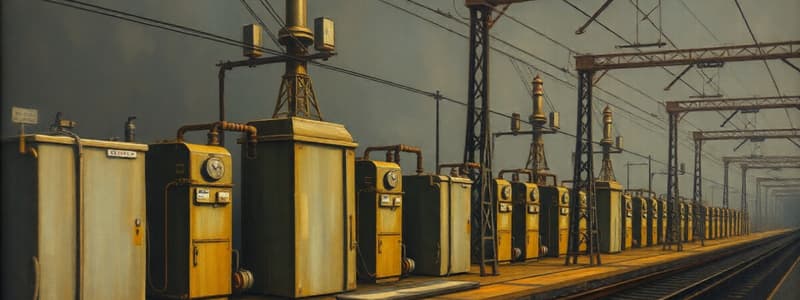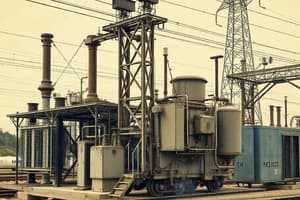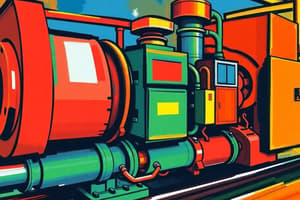Podcast
Questions and Answers
What is the breaking capacity of the interruptor specified for a recovery voltage of 27.5 kV?
What is the breaking capacity of the interruptor specified for a recovery voltage of 27.5 kV?
- 8000 Amps
- 2000 Amps
- 4000 Amps (correct)
- 6000 Amps
Which of the following is a primary function of isolating switches in a sub-station?
Which of the following is a primary function of isolating switches in a sub-station?
- To regulate current flow
- To automatically clear faults
- To create a visible break in the circuit (correct)
- To increase voltage levels
What type of isolating switch is primarily used on the HV side of traction substations?
What type of isolating switch is primarily used on the HV side of traction substations?
- Two post single break type
- Single pole single break type
- Vertical break type
- Centre post rotating double break type (correct)
What is the rated normal current of the new specifications for interruptors according to RDSO?
What is the rated normal current of the new specifications for interruptors according to RDSO?
When should isolating switches be operated regarding the current flow in the circuit?
When should isolating switches be operated regarding the current flow in the circuit?
What is the typical spacing between successive substations in high density routes?
What is the typical spacing between successive substations in high density routes?
What voltage is the incoming supply stepped down to for use in traction substations?
What voltage is the incoming supply stepped down to for use in traction substations?
Which of the following is NOT a voltage level at which Indian Railways purchases electric power?
Which of the following is NOT a voltage level at which Indian Railways purchases electric power?
How did Indian Railways evolve the management of traction substations in the late sixties?
How did Indian Railways evolve the management of traction substations in the late sixties?
What is the role of transformer circuit breakers in traction substations?
What is the role of transformer circuit breakers in traction substations?
Where is the secondary winding of the step down transformer connected?
Where is the secondary winding of the step down transformer connected?
What is the primary purpose of having substations located close to railway traction?
What is the primary purpose of having substations located close to railway traction?
What is the primary function of the feeder breaker in a traction substation?
What is the primary function of the feeder breaker in a traction substation?
Which statement accurately describes the role of the interrupter in a traction substation?
Which statement accurately describes the role of the interrupter in a traction substation?
How many circuit breakers are typically provided at each traction substation?
How many circuit breakers are typically provided at each traction substation?
What is the purpose of the neutral section in a traction supply system?
What is the purpose of the neutral section in a traction supply system?
What do the paralleling interrupters do at each subsectioning post?
What do the paralleling interrupters do at each subsectioning post?
In case of an emergency due to the failure of an adjacent substation, what does the bridging interrupter do?
In case of an emergency due to the failure of an adjacent substation, what does the bridging interrupter do?
What is the role of the transformer breakers in a traction substation?
What is the role of the transformer breakers in a traction substation?
What are the subsectors in the traction supply system divided by?
What are the subsectors in the traction supply system divided by?
Which devices are primarily used to control the supply for each track?
Which devices are primarily used to control the supply for each track?
What is the maximum fault current for a nominal system voltage of 110 kV?
What is the maximum fault current for a nominal system voltage of 110 kV?
What method is used to calculate fault current on the primary side of the substation?
What method is used to calculate fault current on the primary side of the substation?
What is the total reactance when two transformers running in parallel have reactances of 1% and 30%?
What is the total reactance when two transformers running in parallel have reactances of 1% and 30%?
What is the primary purpose of circuit breakers in a power supply system?
What is the primary purpose of circuit breakers in a power supply system?
Which ambient conditions must circuit breakers operate reliably under?
Which ambient conditions must circuit breakers operate reliably under?
For a 20 MVA transformer, what is the assumed short circuit impedance for calculations?
For a 20 MVA transformer, what is the assumed short circuit impedance for calculations?
What is the percentage reactance of the transformer at 100 MVA base if the short circuit impedance is 12%?
What is the percentage reactance of the transformer at 100 MVA base if the short circuit impedance is 12%?
What types of quenching mediums do different circuit breakers use?
What types of quenching mediums do different circuit breakers use?
What is the estimated maintenance cost range for oil circuit breakers as stated?
What is the estimated maintenance cost range for oil circuit breakers as stated?
What is the fault level on the 25 kV bus adjacent to the substation with total reactance of 61%?
What is the fault level on the 25 kV bus adjacent to the substation with total reactance of 61%?
What is the fault current just opposite the substation for a fault level of 163.93 MVA on the 25 kV bus?
What is the fault current just opposite the substation for a fault level of 163.93 MVA on the 25 kV bus?
Which of the following accurately describes the duties of power circuit breakers?
Which of the following accurately describes the duties of power circuit breakers?
What is the maximum fault MVA at a nominal system voltage of 66 kV?
What is the maximum fault MVA at a nominal system voltage of 66 kV?
Which type of circuit breaker was predominantly used by Indian Railways before switching to indigenous manufacturers?
Which type of circuit breaker was predominantly used by Indian Railways before switching to indigenous manufacturers?
If a transformer has a short circuit impedance of 12% at 20 MVA, what would its percentage impedance be at 100 MVA base?
If a transformer has a short circuit impedance of 12% at 20 MVA, what would its percentage impedance be at 100 MVA base?
How do circuit breakers minimize adverse effects during switching operations?
How do circuit breakers minimize adverse effects during switching operations?
What is a significant drawback of using oil circuit breakers as mentioned?
What is a significant drawback of using oil circuit breakers as mentioned?
Which of the following statements is true regarding the fault breaking current for a system with a voltage of 220 kV?
Which of the following statements is true regarding the fault breaking current for a system with a voltage of 220 kV?
Which of the following is NOT a function of power circuit breakers?
Which of the following is NOT a function of power circuit breakers?
What was one of the main reasons for the shift from imported to indigenous manufacturing of circuit breakers by Indian Railways?
What was one of the main reasons for the shift from imported to indigenous manufacturing of circuit breakers by Indian Railways?
What defines electrical clearance in an electrical network?
What defines electrical clearance in an electrical network?
Which of the following is not considered when determining minimum electrical clearances for outdoor switchgear?
Which of the following is not considered when determining minimum electrical clearances for outdoor switchgear?
What is the minimum air safety clearance required for a switchgear with an impulse voltage rating of 145 kV?
What is the minimum air safety clearance required for a switchgear with an impulse voltage rating of 145 kV?
Which clearance is referred to as sectional clearance?
Which clearance is referred to as sectional clearance?
For a switchgear rated at 245 kV, what is the minimum clearance to earth?
For a switchgear rated at 245 kV, what is the minimum clearance to earth?
What is the voltage level to which the incoming supply is typically stepped down for traction substations?
What is the voltage level to which the incoming supply is typically stepped down for traction substations?
What is the average spacing between successive substations in high-density routes?
What is the average spacing between successive substations in high-density routes?
At what voltage does Indian Railways purchase electric power from other utility providers?
At what voltage does Indian Railways purchase electric power from other utility providers?
What aspect of transformer circuit breakers is critical for maintaining electrical safety in traction substations?
What aspect of transformer circuit breakers is critical for maintaining electrical safety in traction substations?
How did the management of traction substations change for Indian Railways in the late sixties?
How did the management of traction substations change for Indian Railways in the late sixties?
Where is one terminal of the secondary winding of the step-down transformer connected?
Where is one terminal of the secondary winding of the step-down transformer connected?
In a traction power supply system, which component ensures the continuity of electrical supply in case of transformer failure?
In a traction power supply system, which component ensures the continuity of electrical supply in case of transformer failure?
What is the maximum fault current that the newly adopted 'Zebra' ACSR conductor can withstand?
What is the maximum fault current that the newly adopted 'Zebra' ACSR conductor can withstand?
What is the diameter of the rigid type bus bar that can carry a continuous current of 1530 Amps?
What is the diameter of the rigid type bus bar that can carry a continuous current of 1530 Amps?
What type of conductors are the bushing type CTs mounted on the primary and secondary side of traction transformers primarily designed for?
What type of conductors are the bushing type CTs mounted on the primary and secondary side of traction transformers primarily designed for?
What is the minimum height requirement for the 25 KV bus bar installation?
What is the minimum height requirement for the 25 KV bus bar installation?
Which conductor was used in earlier electrification schemes before the 'Zebra' ACSR conductor?
Which conductor was used in earlier electrification schemes before the 'Zebra' ACSR conductor?
What is the primary purpose of lightning arresters in a power supply system?
What is the primary purpose of lightning arresters in a power supply system?
What is the tension range that is maintained in the strung bus system?
What is the tension range that is maintained in the strung bus system?
Which type of bus bar is used on the HV side of traction substations?
Which type of bus bar is used on the HV side of traction substations?
What is the continuous current capacity of the rigid type bus before upgrades?
What is the continuous current capacity of the rigid type bus before upgrades?
How are the support insulators for the rigid type bus bar positioned?
How are the support insulators for the rigid type bus bar positioned?
What characteristic of an ideal arrester ensures minimal current during normal operation?
What characteristic of an ideal arrester ensures minimal current during normal operation?
Which type of lightning arrester is designed with a series gap for protection?
Which type of lightning arrester is designed with a series gap for protection?
Which of the following is NOT a consideration when selecting a lightning arrester?
Which of the following is NOT a consideration when selecting a lightning arrester?
What is one advantage of Zinc oxide gapless lightning arresters?
What is one advantage of Zinc oxide gapless lightning arresters?
What is the recommended maximum installation distance for a lightning arrester relative to the protected apparatus?
What is the recommended maximum installation distance for a lightning arrester relative to the protected apparatus?
What is the purpose of having a lower breakdown voltage for a lightning arrester compared to the equipment in the substation?
What is the purpose of having a lower breakdown voltage for a lightning arrester compared to the equipment in the substation?
Which of the following types of lightning arresters is considered outdated due to complexity?
Which of the following types of lightning arresters is considered outdated due to complexity?
What is an important feature of a lightning arrester when considering its performance under environmental conditions?
What is an important feature of a lightning arrester when considering its performance under environmental conditions?
Which voltage level is critical when assessing a lightning arrester's power frequency flashover voltage?
Which voltage level is critical when assessing a lightning arrester's power frequency flashover voltage?
How does the response speed of Zinc oxide gapless lightning arresters compare to other types?
How does the response speed of Zinc oxide gapless lightning arresters compare to other types?
What is the main function of the interrupter in a traction substation?
What is the main function of the interrupter in a traction substation?
What is typically located between adjacent traction substations to separate different phases?
What is typically located between adjacent traction substations to separate different phases?
Which task is NOT performed by the feeder circuit breakers in a traction substation?
Which task is NOT performed by the feeder circuit breakers in a traction substation?
What type of circuits does a paralleling interrupter connect at each subsectioning post?
What type of circuits does a paralleling interrupter connect at each subsectioning post?
What is the function of transformers located in traction substations?
What is the function of transformers located in traction substations?
How many types of circuit breakers are typically provided at each traction substation?
How many types of circuit breakers are typically provided at each traction substation?
In an emergency situation, how does the bridging interrupter assist in traction substations?
In an emergency situation, how does the bridging interrupter assist in traction substations?
What is the purpose of the subsectors created between substations?
What is the purpose of the subsectors created between substations?
What significant structure is provided at each sectioning post to allow for emergency feed?
What significant structure is provided at each sectioning post to allow for emergency feed?
Flashcards
Siding track spacing
Siding track spacing
Siding tracks for loading/unloading heavy equipment should be near railway stations for quick inspection.
Substation Spacing
Substation Spacing
The distance between successive traction substations ranges from 40 to 60 km, depending on traffic density and track conditions.
Traction Power Supply
Traction Power Supply
Indian Railways buys electricity from state electricity boards and other utilities for powering traction substations.
Incoming Power Voltage
Incoming Power Voltage
Signup and view all the flashcards
Transformer Connection
Transformer Connection
Signup and view all the flashcards
Substation Location
Substation Location
Signup and view all the flashcards
Traction Transformer Circuit Breakers
Traction Transformer Circuit Breakers
Signup and view all the flashcards
Feeder Breaker
Feeder Breaker
Signup and view all the flashcards
Interrupter (non-automatic)
Interrupter (non-automatic)
Signup and view all the flashcards
Transformer Breakers
Transformer Breakers
Signup and view all the flashcards
Feeder Circuit Breaker
Feeder Circuit Breaker
Signup and view all the flashcards
Neutral Section (Dead Zone)
Neutral Section (Dead Zone)
Signup and view all the flashcards
Sector
Sector
Signup and view all the flashcards
Subsector
Subsector
Signup and view all the flashcards
Bridging Interrupter
Bridging Interrupter
Signup and view all the flashcards
Traction Substation Layout
Traction Substation Layout
Signup and view all the flashcards
Temperature rise in insulation oil
Temperature rise in insulation oil
Signup and view all the flashcards
Temperature rise current-carrying parts in air
Temperature rise current-carrying parts in air
Signup and view all the flashcards
Circuit breakers
Circuit breakers
Signup and view all the flashcards
Circuit breaker function
Circuit breaker function
Signup and view all the flashcards
Rated short-time withstand current
Rated short-time withstand current
Signup and view all the flashcards
Interruptors
Interruptors
Signup and view all the flashcards
Circuit breaker operation
Circuit breaker operation
Signup and view all the flashcards
Isolating Switches (Isolators)
Isolating Switches (Isolators)
Signup and view all the flashcards
Quenching medium types
Quenching medium types
Signup and view all the flashcards
Breaking Capacity of an Interrupter
Breaking Capacity of an Interrupter
Signup and view all the flashcards
Oil circuit breakers (traction)
Oil circuit breakers (traction)
Signup and view all the flashcards
Off-load switches
Off-load switches
Signup and view all the flashcards
Feeder circuit breaker maintenance
Feeder circuit breaker maintenance
Signup and view all the flashcards
High tripping frequency
High tripping frequency
Signup and view all the flashcards
Substation tripping data (1985)
Substation tripping data (1985)
Signup and view all the flashcards
Fault Current Calculation
Fault Current Calculation
Signup and view all the flashcards
Fault Level (MVA)
Fault Level (MVA)
Signup and view all the flashcards
System Reactance (Xs)
System Reactance (Xs)
Signup and view all the flashcards
Transformer Reactance (Xt)
Transformer Reactance (Xt)
Signup and view all the flashcards
Total Reactance
Total Reactance
Signup and view all the flashcards
Fault Current (kA)
Fault Current (kA)
Signup and view all the flashcards
Single Transformer Fault
Single Transformer Fault
Signup and view all the flashcards
Parallel Transformers Fault
Parallel Transformers Fault
Signup and view all the flashcards
220 kV bus incoming fault
220 kV bus incoming fault
Signup and view all the flashcards
25 kV bus fault
25 kV bus fault
Signup and view all the flashcards
Traction Substation Spacing
Traction Substation Spacing
Signup and view all the flashcards
Voltage Transformation
Voltage Transformation
Signup and view all the flashcards
Neutral Section
Neutral Section
Signup and view all the flashcards
Paralleling Interrupter
Paralleling Interrupter
Signup and view all the flashcards
CTs in Traction Transformers
CTs in Traction Transformers
Signup and view all the flashcards
Bus Bar Types
Bus Bar Types
Signup and view all the flashcards
Strung Bus Conductor Types
Strung Bus Conductor Types
Signup and view all the flashcards
Strung Bus Tension
Strung Bus Tension
Signup and view all the flashcards
Rigid Bus Capacity
Rigid Bus Capacity
Signup and view all the flashcards
Rigid Bus Support
Rigid Bus Support
Signup and view all the flashcards
Lightning Arresters Purpose
Lightning Arresters Purpose
Signup and view all the flashcards
Lightning Arrester Action
Lightning Arrester Action
Signup and view all the flashcards
Minimum Conductor Diameter
Minimum Conductor Diameter
Signup and view all the flashcards
Rigid Bus Height
Rigid Bus Height
Signup and view all the flashcards
Electrical Clearance
Electrical Clearance
Signup and view all the flashcards
Safety Clearance
Safety Clearance
Signup and view all the flashcards
Impulse Withstand Level
Impulse Withstand Level
Signup and view all the flashcards
Minimum Clearance to Earth
Minimum Clearance to Earth
Signup and view all the flashcards
Phase Clearance
Phase Clearance
Signup and view all the flashcards
Lightning Arrester
Lightning Arrester
Signup and view all the flashcards
Ideal Lightning Arrester
Ideal Lightning Arrester
Signup and view all the flashcards
Breakdown Voltage
Breakdown Voltage
Signup and view all the flashcards
Power Frequency Flashover
Power Frequency Flashover
Signup and view all the flashcards
Impulse Flashover Voltage
Impulse Flashover Voltage
Signup and view all the flashcards
Zinc Oxide Gapless Lightning Arrester
Zinc Oxide Gapless Lightning Arrester
Signup and view all the flashcards
Protective Level
Protective Level
Signup and view all the flashcards
Lighting Arrester Installation
Lighting Arrester Installation
Signup and view all the flashcards
Location of Lighting Arrester (Transmission Line)
Location of Lighting Arrester (Transmission Line)
Signup and view all the flashcards
Solid and Direct Connections
Solid and Direct Connections
Signup and view all the flashcards
Study Notes
Traction Substation Spacing and Location
- Substation spacing depends on permissible voltage drop at the farthest point.
- Factors influencing voltage drop include anticipated traffic, future traffic projections, and gradients of the section.
- Calculations consider normal and extended feed conditions, train combinations, loads, speeds, track parameters, and feed zone length.
- Calculations ensure voltage at the farthest end remains within permissible limits.
- Alternatively, power requirement can be calculated based on average specific energy consumption for goods and passenger trains in level or lightly graded sections.
Specific Energy Consumption
- Goods trains: 11 kWh/1000 GTKM
- Passenger trains: 19 kWh/1000 GTKM
- Medium/heavily graded sections require figures based on trials.
Power Requirement Formula
P = Q x (2Lo) x W / (1000 x H x CosØ)2 x Lo= Sub-station covering area for double track line (km)W= Weight of a train in tonesQ= Energy consumption rate (kWh/1000 GTKM)H= Headway in minutes during peak time (assumed)CosØ= Power Factor (lagging)
Traction Substation Considerations
- Availability of reliable power supply lines close to railway lines.
- Willingness of electric supply authorities to extend high-voltage transmission lines.
- Tariff rates for power supply.
- Traffic volume and gradients of the section.
- Future traffic estimations.
- Whether a single or double line section.
Traction Power Supply System
- Indian Railways purchase electric power from state electricity boards.
- Regional grids typically provide power at 220/132/110/66 kV.
- Power is stepped down to 25 kV AC using step-down transformers.
- Primary winding is connected across two phases of the three-phase system.
- One terminal of the 25 kV secondary winding is connected to overhead equipment (OHE).
- The other terminal of the 25 kV secondary winding is solidly earthed and connected to the running rails.
Typical Traction Substation Layout
- Includes two transformers
- Each transformer supplies one OHE.
- Multiple breakers are provided for each side of the transformer.
- Feeder breakers provide normal and abnormal operating conditions.
- Circuit breakers act as backup to feeder breakers.
- Interrupters, or load switches, control the supply to the tracks.
- Dead zones (neutral sections) are used to separate phases.
Traction Power Transformer Characteristics
- Most important and costly piece of substation equipment.
- Initial electrification used 7.3 and 10 MVA.
- Current electrification uses higher capacity transformers (13.5, 20, or 30 MVA).
- Traction transformers handle frequent short circuits and load fluctuations.
- Higher voltage ratings and current handling capacity are required typically.
Circuit Breakers
- Next in importance to the transformer.
- Crucial for controlling and performing power system functions.
- Purpose is to carry rated currents, isolate faulty sections, interrupt load currents, handle capacitive and small inductive currents.
- Oil breakers were traditionally used, SF6 and vacuum breakers are increasingly used in new projects.
- Cost of upkeep and maintenance impacts breaker selection.
Rated Short-Circuit Breaking Current
- Varies between 1,000 MVA to 10,000 MVA depending on the proximity of the generating station
- Breakdown current rating is influenced by voltage class
Substation Insulation Coordination
- Insulators, transformers, and busbars all must be adequately insulated to prevent flashovers.
- Insulation levels are determined by maximum voltage and distances expected to maintain safe operating conditions.
Insulators Technical Specifications
- Creepage distances are designed to accommodate various pollution levels.
- Creepage distance is designed to be 25mm/kV.
Lightning Arresters
- Protect substation equipment from lightning surges and overvoltages.
- Various types are available (rod gap, expulsion, conventional, zinc oxide).
Earthing System
- Critical component in traction substation to prevent high resistance to ground.
- Multiple earth electrodes should be used.
- Earthing system protects people working in the substation, and equipment from faults.
- Earthing system size is influenced by fault current and corrosion.
- The minimum number of earth electrodes is calculated based on the fault current.
Co-ordination Table of Circuit Breakers
- Provides relationships between equipment ratings for proper operation.
- Matching circuit breaker components for reliable system operation.
Studying That Suits You
Use AI to generate personalized quizzes and flashcards to suit your learning preferences.
Related Documents
Description
This quiz covers the spacing and location of traction substations, focusing on the permissible voltage drop at the farthest point. It delves into the calculations related to power requirements for both goods and passenger trains, including specific energy consumption and how various factors influence these metrics.




